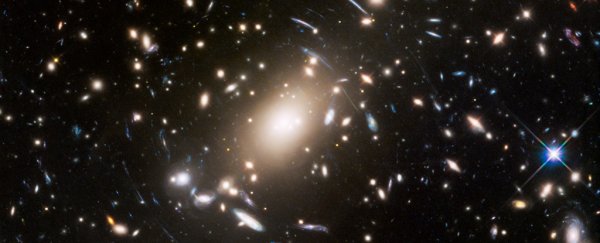In honour of the 50th anniversary of Star Trek, the Hubble Space Telescope has released an image boldly going where no one has gone before.
Peering through a cluster of galaxies to the very edge of the observable Universe to see the First Galaxies themselves.
The Frontier Field (in honour of Star Trek's mission to explore the Final Frontier) is a region of the sky no bigger than a dollar coin seen from 100m away. Yet in that region 4 billion light years distant Hubble sees hundreds of galaxies that form Abell S1063, a galaxy cluster, one of the largest objects in our Universe.
While finding a galaxy cluster would usually be the scientific highlight of the story it's what this cluster allows us to see that's even more exciting.
The streaks or arcs of light you see in the image are optical illusions of even more distant galaxies warped by gravitational lensing.
The image of these background galaxies are brought into 'focus' by the mass of the galaxy cluster. This makes the already incredible Hubble Space Telescope effectively 20 times mores powerful seeing further into the distant universe.
Are you a #StarTrek fan? @NASA_Hubble is and @astroduff runs us through what its new "final frontier" image means https://t.co/GykrIvvr2O
— News Breakfast (@BreakfastNews) July 24, 2016
Since it takes light time to reach us from these distant objects we then see them as they were, just a few hundred million years after the Big Bang. These galaxies are newborns, when the entire universe was barely a teenager relative to its current age.
Gravitational lensing is an effect of General Relativity predicted by Einstein in which that massive objects like stars or galaxies would bend light around them focusing it like a lens. You can test the physics of gravitational lensing at home with a wine glass.
Simply take a sheet of paper and draw a coin-sized dot on it and fill it in, then place a wine glass over it. By looking directly down the stem of the glass the dot will turn into a ring, and looking to the side will see it distorted into streaks and arcs much like the cluster image.
Gravitational lensing allows us to not only see further behind the objects it also allows us to weigh the 'lensing' galaxies themselves as the bending of the light depends on the mass of the object (much as a thicker wine stem of lenses in your glasses will bend the light more).
This reveals that most of the material of the galaxy is in fact invisible, composed of a new form of mass called Dark Matter. While lensing allows us to map the Dark Matter to confirm its nature will require finding it in the lab. Australia has a key role to play in this search with SABRE, the world's first dark matter detector in the Southern Hemisphere.
As we look deeper into the Universe we are seeing it as it was when the light first left. These distant galaxies revealed by the natural lens of the cluster date back to the first few hundred million years after the Big Bang. In astronomy exploring how the very first galaxies formed is the Final Frontier…
Alan Duffy, Research Fellow, Swinburne University of Technology.
This article was originally published by The Conversation. Read the original article.
Swinburne University of Technology is a sponsor of ScienceAlert. Find out more about their innovative research.
![]()
